|
C.I. Hood (Circa: 1910-1922) Size: 8.2" x 5.9" |
Linda & Cliff Hoyt
Last Modified on March 1, 2009
|
C.I. Hood (Circa: 1910-1922) Size: 8.2" x 5.9" |
Do you suffer from torpid liver, scald head, pimples, rheumatism, gout, barber's itch, or That Tired Feeling? If you do, Hood's family of medicines would have had something for you. C.I. Hood & Co. turned out an amazing variety of medicines, but the standard bearer, and mainstay of the company for over half a century, was Hood's Sarsaparilla.
In 1917, Mr. Hood reminisced about the beginnings of his company:
"Forty-two years ago, after ten years of apprenticeship and ownership in an apothecary store, it occurred to me that there was a great opportunity for a business introducing a blood-purifying medicine with efficiency and economy as its base.
"With the ambition and exuberance of young manhood I earnestly determined to make this idea a livewire.
"Fortunately, just at this time, a patient ... brought to my drug store a prescription of unusual ingredients, which produced a remarkable cure for this customer, who had been a great sufferer from blood and nerve troubles ... for several years...
"I took this prescription as a base and perfected a formula for Hood's Sarsaparilla. The sale of this medicine surpassed all my expectations and made the name of Hood known in every city, town, and village in this country and also widely abroad."
Mr. Hood felt that the success of his medicine was due to his care in analysis and experiments conducted with "all the knowledge which modern research in medical science had developed." Taking the successful prescription, he added other well-known vegetable remedies. The result included the following ingredients:
● SARSAPARILLA ROOT--of great service for skin disorders, rheumatism, dropsy, and diseases of a scrofulous origin. (Scrofula is an enlargement of the lymph glands, with abscesses. It originates from tuberculosis. Many problems were due to a scrofulous condition of the blood.)
● UVA URSI--much needed by sufferers from kidney complaints, inflammation of the bladder, chronic diarrhea, diabetes, and troubles of a more delicate nature in either sex.
● BLUE FLAG--especially recommended for scrofula, syphilis, glandular tumors, rheumatism, dyspepsia, constipation, and certain private diseases.
● YELLOW DOCK--remarkable in its effect against scorbutic, cutaneous, scrofulous scirrhous, and syphilitic affections.
● DANDELION--A sign of hope for torpid liver, jaundice, depression, and melancholia.
● GENTIAN--useful for dyspepsia, loss of appetite, exhaustion, gout, and hysteria.
● MANDRAKE--without equal for constipation, scrofula, and skin diseases.
● JUNIPER BERRIES--relieve suffering due to catarrh of the bladder, kidney complaint, and diseases of the urinary organs.
● PIPSISSEWA (Wintergreen)--eminently useful for diseases of the blood, eczema, eruptions, rheumatism, gout, dropsy, and catarrh of the bladder.
● STILLINGIA--eradicates pimples, boils, abscesses, ulcers, syphilis, and chronic bronchitis.
● ALCOHOL (18%)--If the other ingredients didn't cure you, at least you wouldn't feel any pain.
|
Typical C.I. Hood's Sarsaparilla Bottles From Left to Right: 8.9" High 5.6" High 6.9" High 8.7" High Circa: 1878-1922 |
Even though these herbs aren't the great cure-alls they were thought to be, they are being rediscovered by modern scientists In their search for new cures.
When the new medicine was placed on the market in 1876, Hood planned to go ahead carefully, not wanting to make extra and improbable claims." However, his new discovery proved so popular that the business soon outgrew his apothecary store. The company moved to larger quarters in 1879. Finally, in 1882-1883, the company constructed a five-story building, known as Hood's Laboratory. It was enlarged in 1886, 1892, and 1897. The final building had a total floor area of 175,000 square feet, making it the largest building in the world dedicated to the manufacture and sale of patent medicine. This building contained an automatic bottling machine capable of filling 10,000 bottles a day. It also included eighteen tanks, in which sarsaparilla was prepared, which had a capacity of 420,000 bottles.
Sarsaparilla was not the only product produced in the Laboratory--C.I. Hood sold a family of medicines promising to cure most of the illnesses plaguing the human race. Other popular Hood's products were:
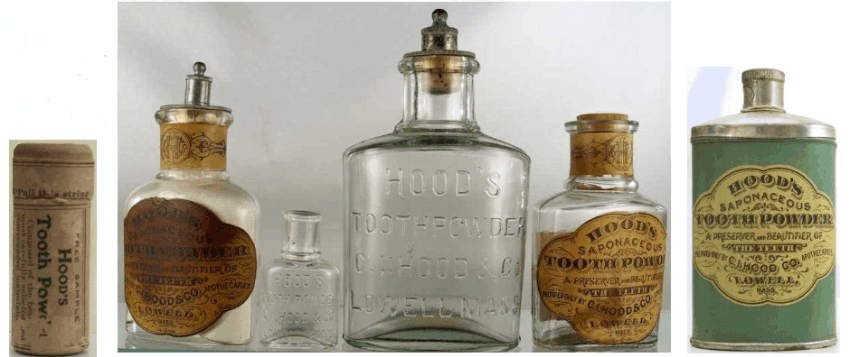
|
C.I. Hood Tooth Powder--cleaned the teeth, sweetened the breath, and neutralized the offensive secretions in the mouth. Wooden tub at left - Size: 2.0"H x 0.7"D; Bottles Size from left to right: 4.1"High (including top); 2.0" High; 4.3" High; 3.5 High, Tin is 4.2" High |
|
C.I. Hood Vegetable Pills--very helpful as a cathartic and liver medicine, the pills also aided digestion, heartburn, headache, jaundice, nausea, and dizziness. Bottle Size: 1.8" High; Wooden Tube Sample Size: 1.7"H x 0.4"D |
|
C.I. Hood Olive Ointment--to be used in scrofula, festers, pimples, piles, boils, bruises, burns, flesh wounds, ingrown nails, and sore nipples. Left To Right: Standard Painted Size: 1.8 dia.; Embossed Tin Size: 1.8 dia. (Detail at left); Sample Tin Size: 1.1 dia.; London Paper Label Size: 1.8 dia. |
|
C.I. Hood Medicated Soap - recommended for skin diseases such as salt rheum, eczema, and scrofula sores. Also used for shaving. Sample Size: 2.1"H x 1.6"W; Regular Size: 3.0"H x 2.2"W |
|
C.I. Hood TusSano--(in Latin, "I cure a cough") was a positive specific for the relief and cure of coughs, colds, hoarseness, bronchitis, asthma, influenza, tonsillitis, and clergyman's sore throat. Regular Size: 6.9" High; Sample Size: 2.2" High |
|
Hood's Peptiron (from Left to Right) Wooden Tube Size: 2.5"H-1.2"D Bottle: $1.00 Round Size: 3.8" high Wooden Tube Sample Size: 1.7"high x 0.6"Dia Bottle: 50¢ Round Size: 2.4" high Bottle: $1.00 Round Size: 3.8" high Bottle: Rectangular 57¢ Size: 2.5" high Bottle: Rectangular $1.13 Size: 3.6" high |
|
Hood's Monaid (from Left to Right) Bottle Sizes: 2.4"H 1.0"D; 3.0"H 1.3"D; 2.9"H x 1.3"D; & 2.6"H x 1.0"D Wooden Tube Sizes: 3.3"H x 1.25"D; & 2.5"H x 1.1"D |
|
Hood's Dyspeplets (from Left to Right) Bottle Sizes: 2.9"H x 1.3"D; 2.9"H 1.3"D; & 4.0" H Wooden Tube Sample Size: 2.0"H x 0.7"D; Wooden Tube (far right) Size: 2.9"H 1.3"D Tin Sizes: 1.0H x 1.7W x 0.3D |
|
Hood's Sarsatabs Wooden Tube Size: 4.2 x 1.6d; Wooden Tube Sample Size: 2.0"H x 0.7"D; Bottle Size: 3.7"H x 1.6"D |
|
Hood's Lotion Bottle Size: 5.5" High Circa: 1915-1922 |
Not all of Hood's products were as popular as Sarsaparilla and Tooth Powder. Some of the lesser lights included Maltobeef, Quinine Hair Tonic, and Oak Tooth Wash. Maltobeef was a delicious emulsion of cod liver oil, extract of malt, and extract of beef. It would cure paleness, thinness, and defects of the bones. Quinine Hair Tonic removed dandruff, crusts, and scurf from the scalp. Oak Tooth Wash was an astringent wash for spongy bleeding gums, and the cure and prevention of canker.
By 1892, the rapid expansion of his business caused Mr. Hood to seek a diversion from his duties. He began Hood's Farm, located three miles from Lowell, and covering 1,200 acres. He began with fifteen head of Jersey cattle, and by 1893 they were winning prizes at the Chicago World's Fair. One winner was Merry Maiden, pictured in many Hood's advertisements, including the Animal Statuettes. Other residents of the farm were repeated winners at state fairs, world's fairs, and the Columbian Exposition. Hood also raised prize-winning hogs, as well as feed crops, fruits, and vegetables. He took pride in his modern farming methods, and the high yield of his crops.
In addition to winning prizes, the farm was also profitable. At one auction held on the farm in 1916, Hood sold 73 cows for a total of $38,705, including one Jersey which brought $5,000. He also developed a set of Farm Remedies, which were advertised in the back of many of his booklets. They must have been fairly successful, as they were advertised over quite a long period of time.
|
|
|
C.I. Hood Farm Liniment Size: 8.9" x 2.8" Circa: 1898-1922 |
C.I. Hood Farm Abortion Remedy Size: 10.3" x 6.5"D Circa: 1898-1922 |
C.I. Hood Farm Disinfectant Size: 3.8"H x 1.5"D Circa: 1898-1922 |
Hood's Farm also produced dairy products. From the reported productivity of his cows, this must have been a thriving business, but the bottles are fairly rare. A final auction was held In 1923, shortly after Mr. Hood's death, and all the stock was sold. We know of no relationship between C.I. Hood's farm and H.P. Hood's Dairy, which still operates in Boston.
Like his farm and his medicines, Hood wanted only the best from his advertising. Like many advertisers of his day, he found the development of color lithography to be a boon, and it filled a need in the life of the common man. The average laborer of the late 1880's led a drab life compared to our existence today. There was no television, radio, or motion pictures, and transportation was slow and difficult. The average worker was hard put to make ends meet and could rarely afford color pictures for his walls. The invention of an inexpensive color printing method changed all this. Families were soon caught up in collecting color prints to decorate their homes, and putting smaller prints in scrapbooks where they could be enjoyed night after night in front of the fireplace.
The advertisers of the day were quick to capitalize on this situation by distributing free color pictures of children, animals, young ladies, and country scenes. These pictures had advertising combined with the design, and text on the back of the extolled the merits of the product. The use of printed advertising developed markets in all parts of the country, and the world. This deluge of printed matter was the first stop taken in the development of name brand products.
Hood's dedication to good patent medicines was equalled by his dedication to good advertising. The Hood Laboratory contained a large, and prolific, advertising department which took almost half of the building. At its height, the printing room contained eighteen cylinder printing presses, two newspaper presses, and a color printing press which was the largest in the world at that time. These presses produced a stream of trade cards, posters, jigsaw puzzles, games, cookbooks, and hundreds of different pamphlets and newspapers.
The glory of the company's advertising style was its calendars. About 150 printers, pressmen, and binders were employed exclusively in the production of the calendars for over five months each year. The artwork was of the highest quality, most of it done especially for these calendars. Not an inch of space was wasted. Each page was filled with almanac information, testimonials, symptoms of diseases, descriptions of products, and coupons for games, puzzles, and other gifts. And with all that, they still managed to squeeze in the days of the month.

|
Hood’s Calendars 1886 - 1893 (Images not to scale) |
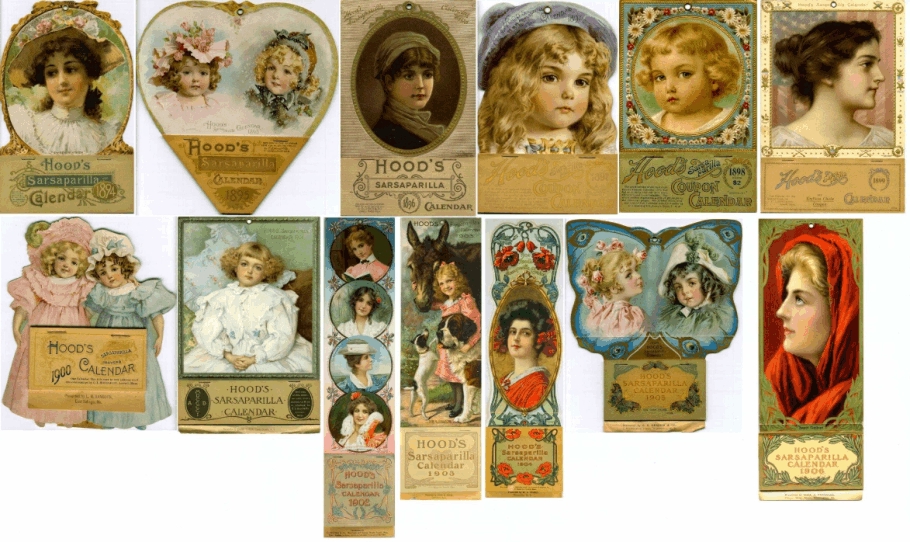
|
Hood’s Calendars 1894 - 1906 (Images not to scale) |

|
Hood’s Calendars 1907 - 1919 (Images not to scale) |
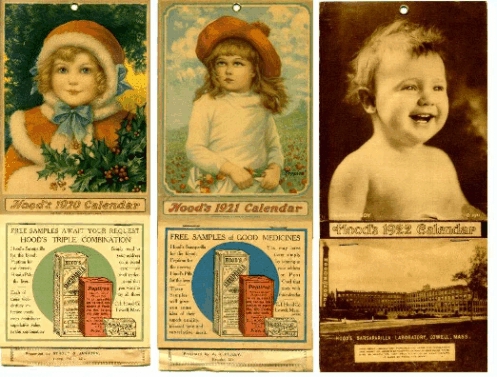
|
Hood's Calendars 1920 - 1922 |
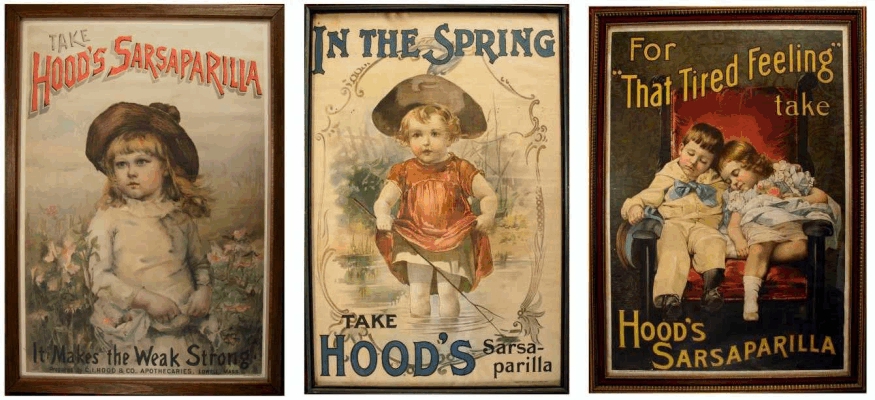
|
C.I. Hood Advertising Signs These signs are all approximately 40" H x 30" W and have copyright dates of 1888 1895, & 1893 from Left to Right |
|
C.I. Hood Counter Displays Girl Size: 18.6h x 9.1w Circa: 1905c; Dog Size: 18.0h x 11.0w Circa: 1917c; Boy Size: 19.00h x 11.00w Circa: 1907c |
|
C.I. Hood Pamphlets Book Size: 9.5"h x 7.6"w Circa: 1899-1900; Bonnet Size:10.5"h x 8.0"w Circa: 1905-1906; Railroad Guide Size: 7.5 x 3.4 Circa: 1894-1910 |
|
C.I. Hood Trade Cards Uncle Sam to John Bull Size: 2.2"h x 4.2"w Circa: 1877c; Factory Size: 3.0h x 4.5w Circa: 1887-1889 |

|
Hood’s Fairies Trade Cards (Circa 1878c, 2.9" x 4.5") There are only four unique images in this set but Hood showed little consistency by advertising different products with each image. |
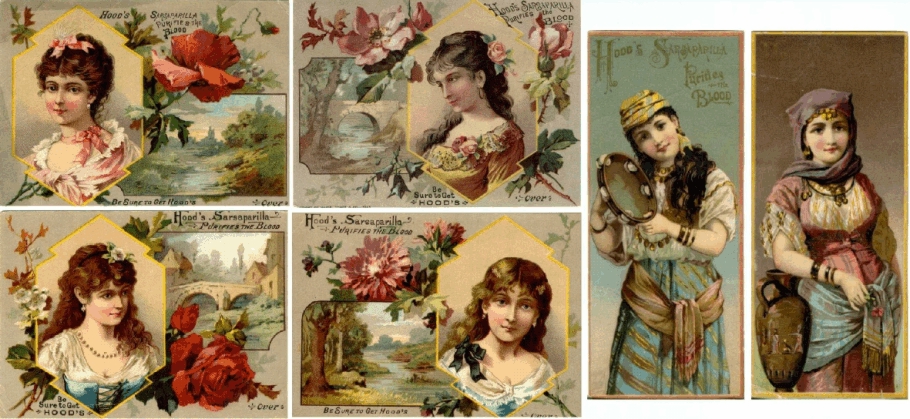 Left Girls in Frames (Circa 1885c, 3.4" x 4.8") Right Gypsies (Circa 1880-1890, 6.3" x 4.8") |
|
The advertising was very effective, and worked something like this: The reader was flooded with an impressive list of symptoms, some of which all healthy people have from time to time. If the reader wasn't already sick, the literature could usually find something that needed fixing or preventing. Hood's, of course had a product that would do it. To a reader now, a hundred years later, and supposedly a little wiser, this literature can still give the feeling that a good belt of sarsaparilla is all he needs for what ails him.
Whatever the curative powers of the Hood's medicines, they must have been doing something right. The number of sarsaparilla bottles still around suggests that the medicine must have done an admirable job of meeting a need felt by a great many people. Mr. Hood took great pride in the quality of everything he did. His advertising certainly deserved this pride, so perhaps his many medicines were equally deserving of the motto:
IF MADE BY HOOD IT'S GOOD